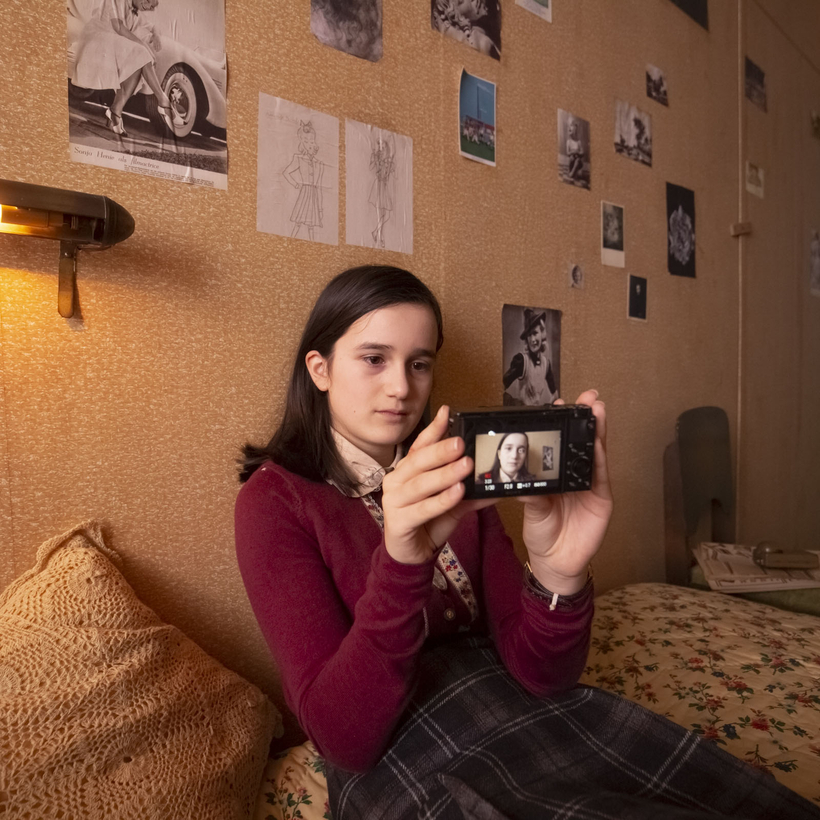What if one of history’s most celebrated diarists had been a vlogger? Now a generation more familiar with the online format can find out, with a modern recast of the tragedy of Anne Frank.
Frank’s story is being retold as a YouTube video diary in which an actress speaks directly to camera like a modern-day vlogger.
The series is mostly filmed in the secret annexe in Amsterdam where the Jewish teenage girl, her family and four others hid from the Nazis until they were discovered. The first episodes already have hundreds of thousands of views, including from British schoolchildren.
The series is mostly filmed in the secret annexe in Amsterdam.
The video diary follows Frank from March 29, 1944, when she was 14 and had been living in hiding for over a year and a half with her parents, Otto and Edith, sister Margot and four others. Anne films herself and her relatives and companions in the annexe, looks back on the time before they went into hiding, talks about the war and shares her thoughts and feelings.
The video diary ends on August 4 when Anne and the seven other people from the secret annexe, as well as two of their non-Jewish helpers, are arrested. Anne died in the Belsen concentration camp in February 1945.
The Anne Frank House said the reason for using YouTube was to reach as many people as possible, especially young people. “Young people spend a lot of time on social media, and that is where they get their information,” the museum, in the building where the Franks hid, said.
It added: “It’s just another format: Anne doesn’t write, she films. What if, on June 12, 1942, she had got a video camera as a birthday present, instead of a diary? Instead of writing diary letters, she would have made video recordings. The camera would have been her diary. She would have vented in front of the camera, talked about her insecurities, anger, desire, love, fears, and hope. She would have talked about the world she lived in, the Netherlands under German occupation, the anti-Jewish measures, and life in the secret annexe. She would have filmed the secret annexe, the people who lived there with her, and the helpers.
What if, on June 12, 1942, she had got a video camera as a birthday present, instead of a diary?
“The strength of the diary is that Anne speaks to you directly and gives you a personal and poignant glimpse into her life. You can’t get any closer to Anne. However, young people read less these days, and for many of them, reading Anne Frank’s diary is a step too far. We want to reach this group in the same personal and poignant way through [video]”
Anne is played by 13-year-old Luna Cruz Perez, who reinterprets Anne’s diary entries in her own words.

Ronald Leopold, executive director of the Anne Frank House, said: “It is one-on-one, personal and poignant. Unlike films about Anne Frank, in which Anne is often played by older actresses and which take an outside perspective, young Luna uses her camera to invite the viewers to connect with Anne, the girl, in a direct way. I hope that many young people will be moved by the video diary and that they will learn about Anne Frank’s life story and start thinking about antisemitism and discrimination today. I also hope that the video diary will encourage young people to read Anne’s diary, her beautifully written diary letters, for themselves.”
“They will learn about Anne Frank’s life story and start thinking about antisemitism and discrimination today.”
Jacqueline van Maarsen, Frank’s friend, who is now 91, said: “I’m excited about this video diary. By replacing the diary with a camera, young people can easily imagine themselves in that situation back then, when Anne Frank lived. The idea took some getting used to, but I think it’s good that Anne Frank’s story has been transferred to modern times.”
Among the British children who have watched the first episodes is Freddie Oldfield, of Manchester, a 14-year-old Anne Frank Ambassador for the Anne Frank Trust UK. He said: “The new video diary is a really great representation of what I already had in my head from reading the diary. I think the video will intrigue people and bring more of the horror of the Holocaust to life. I felt claustrophobic watching it and had guilty thoughts for complaining about being stuck at home because of the coronavirus.”
Sean Wilson, 13, of Greenock, said: “The online presentation allowed me to understand the life that Anne lived whilst in the Attic in Amsterdam.
“Sometimes some people don’t realise the full extent of what she went through … She also listened to the radio and was fully aware of the harsh realities of war and how much danger she was in. She knew fully what the Nazis were trying to do to her and her family [fellow] Jews.”
Sean’s father John, a teacher at St Columba’s High School, Gourock, said: “The online diary will enable our pupils to grasp a deeper understanding of who Anne was and the persecution of the Jewish people. It is very vibrant and detailed. The pupils can watch it at home with their families and share their ideas with family members.”
The 15 episodes, of five to ten minutes each, are being uploaded every Monday and Thursday on youtube.com/annefrank and are in Dutch with English subtitles available.
The series can be seen in Europe but is not yet available in the U.S.

